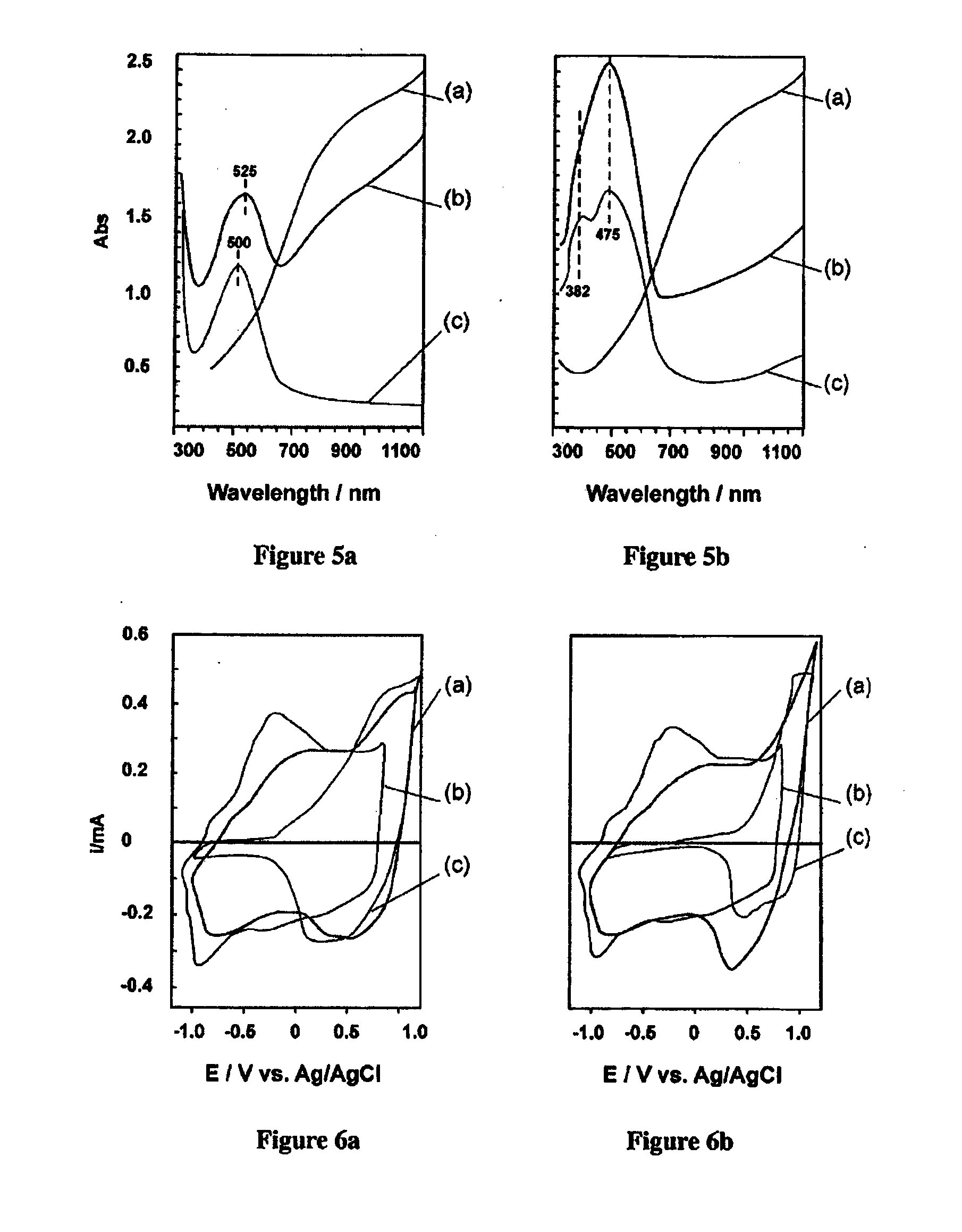Method and system for catalysis
a catalysis and catalyst technology, applied in the field of electrochemical or photo-electrochemical catalysts and electrodes, can solve the problems of low efficiency of organic solar cells, uv or near-uv radiation, unsuitable for solar energy conversion, etc., and achieve the effect of improving the efficiency of electricity generation, improving cost effectiveness, and facilitating charge transport and charge separation
- Summary
- Abstract
- Description
- Claims
- Application Information
AI Technical Summary
Benefits of technology
Problems solved by technology
Method used
Image
Examples
example 1
Interpenetrating Networks (IPNs) Between Two Conjugated Polymers
[0078]The formation of Interpenetrating Networks (IPNs) between two conjugated polymers may be realised for example, in a two-step process where both steps are driven by oxidative polymerization. (B. Winther-Jensen, K. West Synthetic Metals 148 (2005) 105-109). In the first step, one conjugated polymer is chemically polymerized (CP) using an excess of oxidant. In the next step, the remainder of the oxidant is used to polymerise the second conjugated polymer by vapour phase polymerization (VPP). (B. Winther-Jensen, K. West, Macromolecules 37 (2004) 5438-5443.) The CP / VPP terminology used here is neither particularly meaningful nor stringent, but follows a widely accepted practice for each of the individual polymerization techniques.
[0079]To carry out the CP step, a thin film of the reactants dissolved in butanol or ethanol is cast onto the substrate (eg the surface of a glass slide, a PET foil, gold coated mylar, a condu...
example 2
Water Oxidation
[0086]The conjugated polymers PEDOT and PTTh were in-situ polymerized into an interpenetrating network (IPN) of the two polymers according to Example 1. As previously mentioned, when light is shone on the material, electrons in the reduced PTTh are excited into the conduction band. Having PEDOT as a hole conductor adjacent the PTTh offers the possibility of efficient charge separation, where holes move into the PEDOT via the interface while electrons are able to move in the PTTh conduction band. When the PEDOT / PTTh IPN is immersed in an appropriate aqueous electrolyte and a bias potential applied, the holes “pumped” into the PEDOT, due to the light emitted on the sample, are able to drive the oxidation of water. The aqueous electrolyte should be made appropriate and preferably optimised with regard to pH, salinity and soforth.
[0087]As mentioned previously FIG. 1 shows the conversion current of PEDOT / PTTh in water (0.1M NaPTS, pH adjusted to 8) through constant potenti...
example 3
Oxygen Reduction
[0089]For the “reverse” reaction of water splitting, that is, oxygen reduction, the interface works the same way as described above, but in this case the electrons in the PTTh conduction band participate in the oxygen reduction and PEDOT is takes the role of transporting charge (holes) to the outer circuit.
[0090]The efficiency of fuel cells is largely dependant on the electro catalytic reduction of oxygen at the cathode. Traditionally platinum based catalysts have been used and they are still the preferred material for proton conducting membrane fuel cells, which dominate the low temperature field. PEDOT is a possible alternative to platinum for oxygen reduction, but relatively high overpotentials for the reaction under neutral and acidic conditions has limited PEDOT's utility to the highly alkaline fuel cells.
[0091]To study the interface between materials of the present invention as potential candidates as photo enhanced catalysts, attempts were made to lower the ov...
PUM
| Property | Measurement | Unit |
|---|---|---|
| area | aaaaa | aaaaa |
| pH | aaaaa | aaaaa |
| reduction potential | aaaaa | aaaaa |
Abstract
Description
Claims
Application Information
 Login to View More
Login to View More - R&D
- Intellectual Property
- Life Sciences
- Materials
- Tech Scout
- Unparalleled Data Quality
- Higher Quality Content
- 60% Fewer Hallucinations
Browse by: Latest US Patents, China's latest patents, Technical Efficacy Thesaurus, Application Domain, Technology Topic, Popular Technical Reports.
© 2025 PatSnap. All rights reserved.Legal|Privacy policy|Modern Slavery Act Transparency Statement|Sitemap|About US| Contact US: help@patsnap.com



